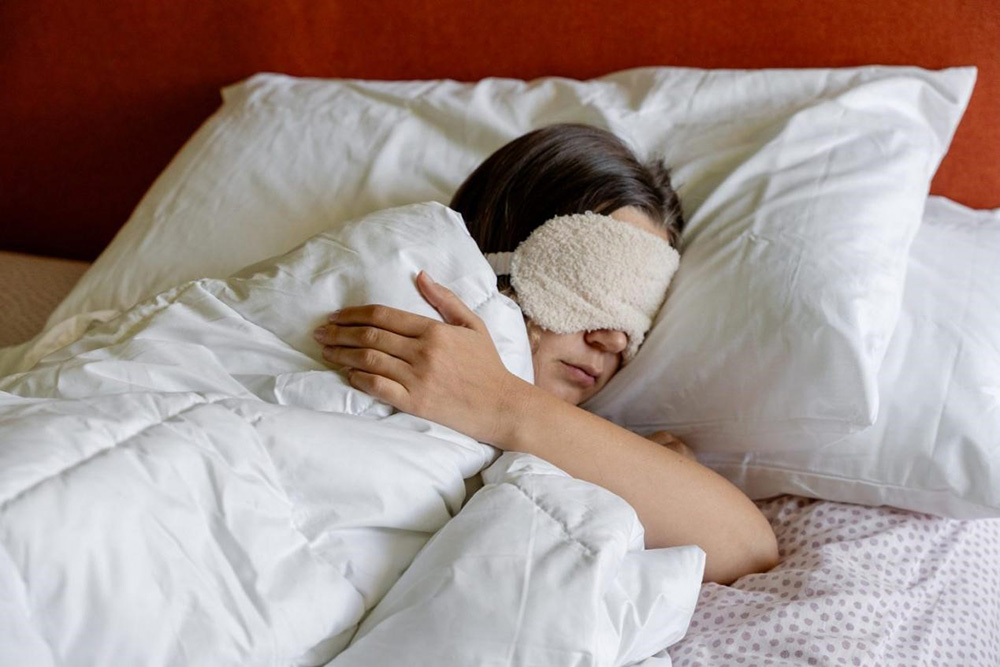
一直以來,醫(yī)學界都把保證優(yōu)質睡眠作為保持身心健康和延緩衰老的首要生活習慣,,保證優(yōu)質睡眠還能降低患心臟病等慢性疾病的風險,。網(wǎng)上也有也很多優(yōu)質睡眠小妙招,有的讓你睡前用膠帶封住嘴巴,,有的讓你睡前洗熱水澡,,還有的讓你睡覺前把手機鎖起來。越來越多的人也開始追求所謂的“極致睡眠”,,他們孜孜不倦地追求各種助眠妙招,,以獲得更高質量的睡眠。其中一個“助眠黑科技”叫做“認知洗牌睡眠法”,,它是“數(shù)綿羊”的近親,,但是操作起來更隨意。
那么,,什么是“認知洗牌睡眠法”,,它真的像宣傳的那樣有效嗎?專家們對此做出了解釋,。
什么是“認知洗牌睡眠法”,?
“認知洗牌睡眠法”,是指你故意聯(lián)想一些彼此沒有關聯(lián)的詞語,,通過創(chuàng)造一種隨機性,,來分散你的注意力,從而降低你的情緒反應和清醒程度的方法,。TikTok上的一位醫(yī)生表示,,這種方法“能像洗牌一樣重整你的思緒”,這種隨機性也很容易觸發(fā)我們?nèi)胨敖?jīng)常會做的那種零散的夢,,從而有助于引導入睡,。
舉個例子,你可以從英文字母表里隨便選一個字母,,比如字母B,,然后每隔5到10秒鐘,,想出一個以該字母開頭的單詞,例如船(boat),、鮮花(bouquet),、面包(bread)。在你想到這個單詞的同時,,你的腦中就會自然而然地呈現(xiàn)出與之對應的畫面,。
睡眠呼吸暫停癥治療公司Complete Sleep的醫(yī)療總監(jiān)大衛(wèi)?羅森對《財富》表示:“認知洗牌睡眠法是一種心理助眠法,它的目的是干擾大腦的邏輯性和專注性的思考傾向,,從而幫人入睡?!?/p>
“認知洗牌睡眠法”最早是由認知科學家呂克?博杜安提出的,。在2016年的一項研究中,博杜安發(fā)現(xiàn),,與“睡前寫下困擾你的事”相比,,“認知洗牌睡眠法”的助眠效果更好,操作起來也更簡單,。
羅森指出:“研究表明,,進行非線性的、略帶隨機性的思考,,能夠干擾人的分析性思維,,而分析性思維是讓人難以入睡的重要原因。這種睡眠法的核心原則也符合我們對睡眠轉換相關認知過程的認識,?!?/p>
我應該嘗試“認知洗牌睡眠法”嗎?
羅森表示,,這種睡眠法對失眠的人確實有效,,特別是對那些容易在夜間大腦過度活躍,總是無法停止思考和憂慮的人,。
他介紹道:“這種方法可以讓人分散注意力,,同時又不會提升人的清醒程度。如果你是一個總是想得太多,,又很難放松精神的失眠者,,這種方法絕對值得一試?!?/p>
這種方法還有無副作用和操作簡便等優(yōu)點,,更不用說它還是完全免費的。
哈佛醫(yī)學院助理教授,、布萊根婦女醫(yī)院睡眠科學家麗貝卡?羅賓斯醫(yī)生指出,,雖然這種方法不像其他助眠手段那樣有充分的科學依據(jù),,但這并不意味著它不起作用。她對《財富》表示:“睡前的最佳活動,,就是那些能幫助我們從忙碌的一天抽離出來,,進而進入睡眠狀態(tài)的活動?!?/p>
羅森指出,,“認知洗牌睡眠法”與其他睡眠方法配合使用,效果會更好,。比如你可以養(yǎng)成睡前放松的習慣,,讓身體和大腦在入睡前平靜下來(比如關掉手機,讓臥室保持昏暗涼爽的環(huán)境,,以及練習深呼吸等),。
一位名叫布林莎?瓦薩加爾的家庭醫(yī)生也表示,“認知洗牌睡眠法”是一種非常有用的助眠手段,,它在很多方面類似于認知行為療法,,而認知行為療法也是一種科學有效的治療失眠的方法。她說:“這些單詞的隨機性,,就是在模仿大腦在準備入睡時產(chǎn)生的那些隨意的想法,。”
如您一周有3晚以上失眠,,且這種癥狀已經(jīng)持續(xù)了3個月以上,,請及時到睡眠專科就診,。 (財富中文網(wǎng))
譯者:樸成奎
一直以來,,醫(yī)學界都把保證優(yōu)質睡眠作為保持身心健康和延緩衰老的首要生活習慣,保證優(yōu)質睡眠還能降低患心臟病等慢性疾病的風險,。網(wǎng)上也有也很多優(yōu)質睡眠小妙招,,有的讓你睡前用膠帶封住嘴巴,有的讓你睡前洗熱水澡,,還有的讓你睡覺前把手機鎖起來,。越來越多的人也開始追求所謂的“極致睡眠”,他們孜孜不倦地追求各種助眠妙招,,以獲得更高質量的睡眠,。其中一個“助眠黑科技”叫做“認知洗牌睡眠法”,它是“數(shù)綿羊”的近親,,但是操作起來更隨意,。
那么,什么是“認知洗牌睡眠法”,,它真的像宣傳的那樣有效嗎,?專家們對此做出了解釋,。
什么是“認知洗牌睡眠法”?
“認知洗牌睡眠法”,,是指你故意聯(lián)想一些彼此沒有關聯(lián)的詞語,,通過創(chuàng)造一種隨機性,來分散你的注意力,,從而降低你的情緒反應和清醒程度的方法,。TikTok上的一位醫(yī)生表示,這種方法“能像洗牌一樣重整你的思緒”,,這種隨機性也很容易觸發(fā)我們?nèi)胨敖?jīng)常會做的那種零散的夢,,從而有助于引導入睡。
舉個例子,,你可以從英文字母表里隨便選一個字母,,比如字母B,然后每隔5到10秒鐘,,想出一個以該字母開頭的單詞,例如船(boat),、鮮花(bouquet),、面包(bread)。在你想到這個單詞的同時,,你的腦中就會自然而然地呈現(xiàn)出與之對應的畫面,。
睡眠呼吸暫停癥治療公司Complete Sleep的醫(yī)療總監(jiān)大衛(wèi)?羅森對《財富》表示:“認知洗牌睡眠法是一種心理助眠法,它的目的是干擾大腦的邏輯性和專注性的思考傾向,,從而幫人入睡,。”
“認知洗牌睡眠法”最早是由認知科學家呂克?博杜安提出的,。在2016年的一項研究中,,博杜安發(fā)現(xiàn),與“睡前寫下困擾你的事”相比,,“認知洗牌睡眠法”的助眠效果更好,,操作起來也更簡單。
羅森指出:“研究表明,,進行非線性的,、略帶隨機性的思考,能夠干擾人的分析性思維,,而分析性思維是讓人難以入睡的重要原因,。這種睡眠法的核心原則也符合我們對睡眠轉換相關認知過程的認識?!?/p>
我應該嘗試“認知洗牌睡眠法”嗎,?
羅森表示,,這種睡眠法對失眠的人確實有效,特別是對那些容易在夜間大腦過度活躍,,總是無法停止思考和憂慮的人,。
他介紹道:“這種方法可以讓人分散注意力,同時又不會提升人的清醒程度,。如果你是一個總是想得太多,,又很難放松精神的失眠者,這種方法絕對值得一試,?!?/p>
這種方法還有無副作用和操作簡便等優(yōu)點,更不用說它還是完全免費的,。
哈佛醫(yī)學院助理教授,、布萊根婦女醫(yī)院睡眠科學家麗貝卡?羅賓斯醫(yī)生指出,雖然這種方法不像其他助眠手段那樣有充分的科學依據(jù),,但這并不意味著它不起作用,。她對《財富》表示:“睡前的最佳活動,就是那些能幫助我們從忙碌的一天抽離出來,,進而進入睡眠狀態(tài)的活動,。”
羅森指出,,“認知洗牌睡眠法”與其他睡眠方法配合使用,,效果會更好。比如你可以養(yǎng)成睡前放松的習慣,,讓身體和大腦在入睡前平靜下來(比如關掉手機,,讓臥室保持昏暗涼爽的環(huán)境,以及練習深呼吸等),。
一位名叫布林莎?瓦薩加爾的家庭醫(yī)生也表示,,“認知洗牌睡眠法”是一種非常有用的助眠手段,它在很多方面類似于認知行為療法,,而認知行為療法也是一種科學有效的治療失眠的方法,。她說:“這些單詞的隨機性,就是在模仿大腦在準備入睡時產(chǎn)生的那些隨意的想法,?!?/p>
如您一周有3晚以上失眠,且這種癥狀已經(jīng)持續(xù)了3個月以上,,請及時到睡眠??凭驮\。 (財富中文網(wǎng))
譯者:樸成奎
March 31, 2025 at 11:59 PM GMT+8Doctors have long pointed to good sleep as the number one lifestyle choice to stay physically and mentally healthy and age well, reducing the risk of chronic conditions like heart disease. Countless videos on social media—touting everything from taping your mouth shut while you sleep, to taking late, warm showers and using phone lockboxes—have enticed a growing group of “sleepmaxxers,” who are obsessed with trying different strategies to help them clock more quality shut-eye. One hack users swear by is called cognitive shuffling, a cousin of the counting-sheep method, but more random.
What is cognitive shuffling, and is it worth the hype? Experts explain.
What is cognitive shuffling?
Cognitive shuffling is when you purposely focus on words that do not correlate to one another, introducing a randomness that can distract you and not emotionally engage you enough to keep you awake. One doctor on TikTok says the method helps “rearrange or reorganize your thoughts similar to shuffling a deck of cards,” and that the randomness mirrors the micro dreams of thought that transition us to sleep.
For example, pick one letter of the alphabet, like “B,” and then come up with words every five to 10 seconds that start with that letter: boat, bouquet, and bread. Your brain will naturally come up with images to visualize these words.
“Cognitive shuffling is a mental technique designed to help people fall asleep by interrupting the brain’s tendency to engage in logical, focused thinking,” Dr. David Rosen, the medical director at Complete Sleep, a sleep apnea treatment company, tells Fortune.
Cognitive scientist Luc P. Beaudoin introduced the practice. In a 2016 study, he found that people who tried the method alongside the technique of jotting down worries before bed found cognitive shuffling helped more and was easier to adopt.
“Research indicates that engaging in nonlinear, slightly random thinking can disrupt the analytical thinking that often keeps people awake,” Rosen says. “The core principles align with what we know about attention, working memory limitations, and the cognitive processes involved in sleep transitions.”
Should I try cognitive shuffling?
Rosen says this method can help people who struggle to fall asleep and may be especially useful for those who have an overactive brain at night and can’t seem to turn off rumination and worry.
“It works by creating a form of mental distraction that’s engaging enough to hold attention but not stimulating enough to increase alertness,” he says. “It’s definitely worth trying for those with insomnia characterized by racing thoughts or difficulty winding down mentally.”
It’s also harmless, free, and accessible, he adds.
While Dr. Rebecca Robbins, assistant professor at Harvard Medical School and sleep scientist at Brigham and Women’s Hospital, says the technique is not thoroughly backed by science like other tools, it doesn’t mean it can’t work. “The best activities before bedtime are those that help us disconnect from our busy day and slip into sleep,” she tells Fortune.
Rosen says the practice may be most helpful alongside other sleep hygiene tools, like having a wind-down routine to calm the body and brain down before bed (think turning off screens, making your bedroom dark and cool, and practicing deep breathing).
Dr. Brintha Vasagar, a family physician, has found the tool beneficial and says it is similar in many ways to cognitive behavioral therapy (CBT), a scientifically backed treatment for insomnia. “The randomness of these words also mimics the random thoughts that our brain drifts to as it prepares for sleep,” she says.
For those who are consistently unable to fall and stay asleep for three nights a week for three months, see a sleep specialist to help diagnose and address a potential sleep disorder.






